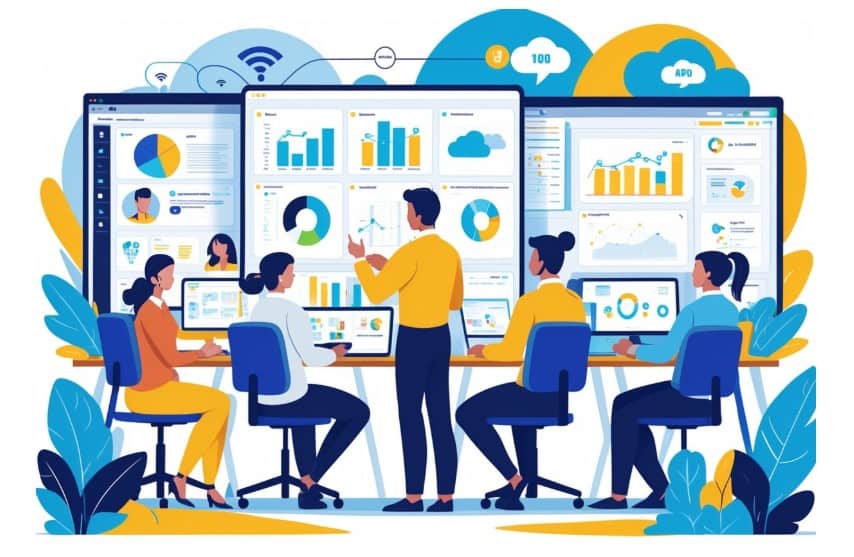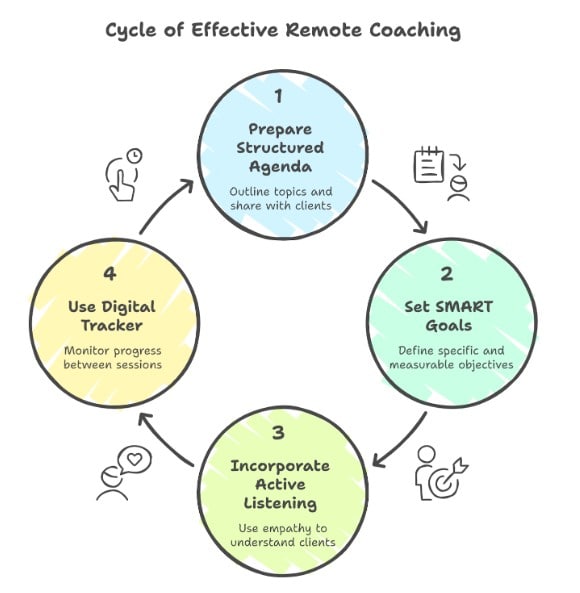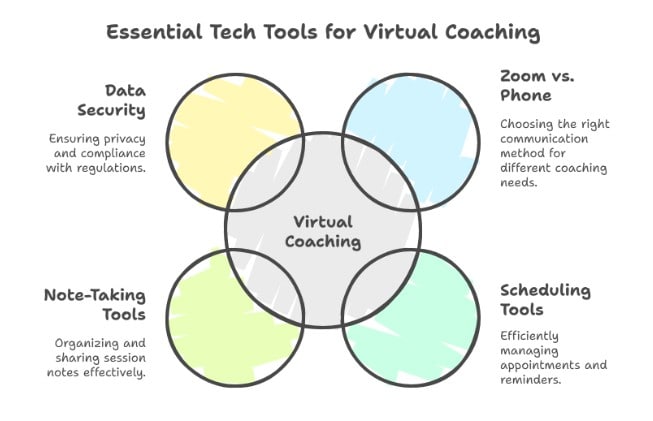
Remote Coaching: Strategies for Virtual Performance Improvement in the Digital Workplace Era
Remote work has flipped the script on how teams get things done. But it’s also thrown up some fresh challenges when it comes to helping people improve.
Many managers and coaches are still figuring out how to support their folks when everyone’s scattered.
Virtual coaching offers proven strategies to bridge this gap and deliver meaningful performance improvements regardless of physical distance.
The shift to remote work doesn’t have to water down coaching’s impact. Coaching in remote or hybrid environments prompts managers to think creatively and find innovative ways to empower their teams.
With the right approach, virtual coaching can have just as much impact as traditional, in-person sessions.
This guide explores practical techniques for establishing strong coaching relationships through video screens.
We’ll discuss selecting the right technology, tracking progress across time zones, and establishing effective accountability systems for remote work.
You’ll also find some real-world methods for measuring coaching success when everyone’s logging in from somewhere else.
Key Takeaways
- Remote coaching is a powerful way to enhance professional performance, eliminating the need for in-person meetings and making it ideal for today’s hybrid and remote work environments.
- Consistency, personalization, and structure are the cornerstones of successful virtual coaching, helping clients stay focused, motivated, and accountable.
- The right tools—like video calls, shared documents, and progress trackers—can enhance engagement and help coaches deliver real-time, collaborative support.
- Virtual coaching adapts to various learning styles and goals, making it highly effective for professionals at all career stages who seek long-term growth.
At a Glance: Remote Coaching Strategies That Work

Remote coaching has been shaking up how organizations develop talent. Digital tools and AI-powered analytics enable coaches to tailor feedback in real-time, even during video calls.
This approach brings professional guidance to anyone, anywhere, without losing its punch.
Key Benefits:
- Global accessibility for clients and coaches
- Real-time performance insights with AI analysis
- Personalized coaching strategies based on data
- Cost-effective talent development solutions
AI coaching platforms improve performance by tracking client behavior and communication patterns. Coaches can shift gears on the fly based on what they see.
Essential Components:
| Element | Purpose |
| Video platforms | Face-to-face interaction |
| AI analytics | Performance tracking |
| Digital tools | Content delivery |
| Feedback systems | Progress monitoring |
Remote coaching requires new strategies when managers lead geographically dispersed teams. The key? Really understanding how each person works—and how the team fits together.
Critical Success Factors:
- Building rapport in virtual environments
- Using data-driven coaching approaches
- Implementing continuous feedback loops
- Customizing learning programs for each client
AI-assisted coaching enables organizations to onboard new hires and upskill teams more efficiently. The tech allows for coaches to measure impact and create learning experiences that adapt to individuals’ needs.
These days, the best remote coaching blends human expertise with artificial intelligence. That combo delivers results you can measure, no matter the industry.
What Is Remote Coaching — And Why Does It Matter Today?
Remote coaching isn’t just a pandemic workaround anymore. It’s become a go-to strategy for professional development at every level.
Modern workforces want flexibility and easy access to career growth, and remote coaching meets them right where they are.
Remote coaching is a professional mentorship that occurs entirely online. Coaches and clients connect through digital platforms for real conversations and growth.
This isn’t just a watered-down version of in-person sessions. It uses tech to deliver personalized guidance, sometimes even more efficiently.
Key characteristics of remote coaching include:
- Real-time video sessions on Zoom, Teams, or similar platforms
- Goal-setting and accountability frameworks that are structured
- Digital resource sharing and progress tracking
- Flexible scheduling across time zones
The focus stays on real professional outcomes—think leadership skills, career advancement, and performance improvements that matter.
Remote coaching isn’t just another online training program. It’s built around one-on-one or small group sessions, tailored to what each person (and their organization) needs most.
Virtual coaching breaks down geographic barriers, enabling clients to connect with coaches worldwide. Suddenly, you can tap into expertise that just doesn’t exist in your backyard.
Importance of Hybrid/Remote Workforces Post-Pandemic
When the pandemic struck, approximately 70% of workers transitioned to remote roles almost overnight. That’s wild.
This massive shift made virtual coaching a must-have for professional development and leadership training.
Remote teams face unique challenges that coaching addresses:
- Isolation and disconnection from colleagues and company culture
- Communication gaps that impact collaboration and productivity
- Work-life boundary confusion leading to burnout
- Reduced informal mentoring opportunities
Remote coaching is no longer a luxury but an operational imperative for organizations wanting to stay competitive. Companies use it to keep people engaged and growing, regardless of where they work from.
Team coaching, in particular, has become a lifeline for remote teams. It helps establish clear communication, builds trust across distances, and fosters shared accountability.
The hybrid workforce model demands new management styles. Remote coaching helps managers develop empathy and emotional intelligence—skills that are particularly essential when your team members might be feeling isolated.
Key Benefits Of Virtual Coaching For Professionals
Virtual coaching offers significant advantages in how professionals develop skills and advance in their careers.
Think more flexible schedules, more frequent sessions, better privacy, and customized approaches that fit your goals.
Flexibility And Accessibility
Virtual coaching wipes out the usual barriers—no more worrying about location or time zones. If you’ve got Wi-Fi, you’re in.
People in rural or underserved areas can now access exceptional coaching that was previously unavailable. That’s a game-changer for a lot of folks.
Flexible scheduling allows you to fit in a session during lunch, before work, or after the kids are in bed. No traffic, no hassle.
Since there’s no commute, you get more time back for family or just, you know, life. That’s a relief for busy professionals everywhere.
Key flexibility advantages include:
- No geographic limitations
- 24/7 scheduling possibilities
- Shorter time commitment per session
- No travel costs or logistics headaches
Increased Session Frequency And Consistency
Virtual platforms make it easy to connect more often and in different ways. That keeps development moving and stops things from stalling between big sessions.
Coaches can check in with a quick video call, phone chat, or even a message. Those little nudges help people stay on track and address issues as they arise.
It’s just easier to stick to a coaching schedule when you don’t have to leave your desk. Fewer cancellations, more progress.
Frequency benefits include:
- Weekly or bi-weekly sessions are more attainable now
- Quick 15-minute check-ins in between
- Support right when you need it
- Better completion rates for coaching programs
Regular virtual sessions build strong accountability. People form better habits and hit their goals faster with that steady support.
Confidentiality And Comfort From One’s Own Environment
There’s something about being in your own space—it just makes it easier to open up. People tend to get real about their challenges when they’re comfortable.
You don’t have to worry about someone spotting you at a coach’s office. That extra privacy matters, especially for execs or anyone in a small industry where word travels fast.
When you’re at ease, the conversations go deeper. There’s less distraction, less social anxiety, and more focus on what’s important.
Privacy advantages include:
- Total confidentiality
- Less worry about what others think
- Comfort of your own space
- Greater emotional safety
Virtual coaching allows you to adjust your environment—lighting, chair, and other elements—that work best for you, enabling you to get the most out of every session.
How Virtual Coaching Supports True Personalization
Virtual coaching empowers professionals with tailored strategies that go far beyond one-size-fits-all advice.
By leveraging digital platforms, Fettner Executive & Professional Career Coaching delivers highly customized experiences that adjust to each client’s goals, challenges, and learning style.
Here’s how personalization comes to life in remote coaching:
- Progress Tracking & Analytics
Digital tools log milestones, goals, and patterns, allowing coaches to adjust strategies in real-time. - Custom Resource Delivery
Clients receive handpicked reading materials, exercises, and preparation guides tailored to their specific focus areas. - Live Collaboration & Feedback
Screen-sharing, document reviews, and real-time coaching notes make every session interactive and actionable. - Adaptable Communication Styles
Whether clients prefer visual aids, structured agendas, or reflective conversation, virtual coaching adapts.
This flexible, data-informed approach reflects Fettner’s commitment to delivering coaching that’s not only accessible but truly effective for each individual.
Looking for real progress in a remote work environment? Fettner Executive & Professional Career Coaching offers virtual career coaching to help you stay focused, productive, and purpose-driven. Contact us to get started.
Best Practices For Video And Phone-Based Coaching

Remote coaching works best with structured planning, clear goal setting, empathetic communication, and consistent tracking.
These basics help coaches build trust and actually move the needle for clients, even from a distance.
Prepare A Structured Agenda For Each Session
A clear agenda keeps virtual sessions on track. Coaches outline topics, set time for each point, and share the plan with clients a day or two in advance.
The agenda typically covers three key areas: a review of previous goals, a discussion of current challenges, and action planning. This approach helps keep sessions moving and ensures nothing slips through the cracks.
Reliable video conferencing platforms minimize technical headaches that can disrupt the flow. Coaches should check their tech before each session and have a backup plan ready.
Time management matters even more online. Assigning a set time to each topic helps cover everything without running over.
Set SMART Performance Goals
Performance coaching only works if clients have clear, measurable goals. SMART goals keep things on track in remote coaching relationships.
Specific goals remove confusion. Instead of “improve communication skills,” a coach might guide a client to “lead three team meetings per week using active listening techniques.”
Measurable goals help everyone track progress. Time-bound goals add a bit of healthy pressure and accountability that can otherwise fade online.
Coaches should record these goals in a digital format that clients can access anytime. This keeps everyone honest and provides a reference for future sessions.
Incorporate Active Listening And Reflective Feedback
Because remote coaching provides fewer visual cues than in–person coaching, active listening and reflective discussion are even more important in virtual coaching interactions. Pausing to check understanding and ask clarifying questions are effective strategies for coaches to employ. Using phrases like “What I’m hearing is…” or “It sounds like you’re feeling…” show empathy and help avoid misunderstandings.
Empathy and emotional intelligence play a crucial role when clients feel isolated or overwhelmed. Coaches must listen for emotional undertones that may not always be apparent online.
Reflective feedback sums up the main points and emotions from the session. This helps clients process their thoughts and feelings.
Use A Coaching Journal Or Digital Tracker Between Sessions
Tracking progress between meetings keeps things moving. Digital tools enable coaches and clients to monitor progress in real-time.
Coaches should suggest tracking methods that fit each client’s comfort level—this could be an app, a shared document, or just email check-ins.
The tracking system should capture numbers and personal notes. Clients get more out of coaching when they jot down challenges, wins, and insights as they go.
Examining this data together helps coaches identify patterns and refine their approach. It makes sessions more focused and increases the odds of real change.
Essential Tech Tools For Effective Virtual Coaching

The right tech stack can make sessions smoother and more engaging. Mastering virtual coaching involves selecting reliable platforms, utilizing easy-to-use scheduling tools, and implementing robust privacy practices.
Zoom Vs. Phone: When And Why To Use Each
Zoom is great for complex coaching conversations that need visual cues or interactive tools. It offers breakout rooms for group sessions and easy document sharing.
Video calls help coaches read body language and build trust, especially during first meetings.
Phone calls are more effective for quick check-ins, discussing sensitive topics, or when clients prefer not to be on camera.
Technical details matter when choosing a platform. Zoom needs a solid internet connection and can drain batteries. Phone calls work almost anywhere and use less data.
Some clients prefer phone sessions for the casual vibe. Others want video so they can see reactions and use visual aids.
Tools For Scheduling (Calendly), Note-Taking (Notion, Google Docs)
Calendly takes the hassle out of scheduling. Coaches set their availability, add buffer times, and send reminders automatically.
It syncs with most calendars and video tools. Calendly also accommodates time zones for clients worldwide.
Notion acts as an all-in-one workspace. Coaches can organize client notes, track goals, and build templates for sessions.
Clients can access shared goal-tracking pages in Notion. The platform’s flexibility means coaches don’t have to juggle a bunch of different apps.
Google Docs is ideal for taking real-time notes and completing homework. Both the coach and client can edit at the same time during a session.
These tools save version history and work offline when needed. Google Docs also integrates seamlessly with other popular apps.
Data Security And Privacy Tips For Clients
End-to-end encryption keeps coaching conversations private. Coaches should double-check that their video platforms offer this by default.
Platforms like Zoom now offer waiting rooms and password protection. These features keep uninvited guests out of private sessions.
Client data storage needs to follow privacy laws. Coaches should utilize cloud services that comply with GDPR and other relevant regulations.
Virtual whiteboards and note-taking apps should have robust security—consider implementing two-factor authentication and conducting regular audits.
Password management is a big deal when using multiple platforms. Strong, unique passwords for each tool help prevent breaches.
Coaches should agree with clients on how long to keep session recordings and when to delete files. Clear policies build trust.
Remote coaching can transform how you show up professionally. Fettner Executive & Professional Career Coaching helps you build consistent momentum, even from a remote or hybrid setup. Schedule your first virtual session today.
How To Maintain Accountability Without In-Person Meetings
Remote coaching relies on systems to monitor progress and ensure everyone remains accountable.
Setting clear expectations, utilizing shared tools, and maintaining regular contact all help maintain accountability, regardless of the distance.
Establish Clear Expectations And Timelines
Clear expectations are the backbone of remote accountability. Coaches need to clearly outline specific outcomes, deadlines, and success metrics from the outset.
Written agreements beat verbal promises in virtual settings. They should list what clients will achieve, by when, and how progress will be measured.
SMART goals are the gold standard for remote coaching:
- Specific: Define exact outcomes
- Measurable: Use numbers or clear indicators
- Achievable: Set realistic targets
- Relevant: Tie to bigger objectives
- Time-bound: Add realistic deadlines
Breaking big goals into weekly milestones helps clients stay on track and move forward. Each milestone should have its own deadline and criteria for success.
Building accountability in remote teams takes clear steps and a sense of ownership. The same goes for one-on-one coaching.
Use Shared Documents Or Goal Sheets
Shared tracking tools enable both the coach and client to see progress in real-time. Google Sheets, Notion, or just a shared Google doc can work for most.
Goal sheets should cover these basics:
| Element | Purpose |
| Current Goal | What the client is working toward |
| Action Steps | Specific tasks to complete |
| Due Date | When should each step finish |
| Status | In progress, complete, or blocked |
| Notes | Challenges or wins to discuss |
Clients update these sheets between sessions. This makes progress visible and keeps everyone accountable.
Some coaches use simple color codes—green for on track, yellow for slight delays, red for major issues.
The trick is to keep updates quick and easy. Complicated systems usually get dropped after a while.
Check-Ins Via Email, SMS, Or Asynchronous Voice/Video Messages
Regular check-ins help maintain momentum between sessions. Remote coaching delivery methods include calls, video, recordings, and emails—whatever fits.
Email check-ins are good for weekly updates. Coaches often use three quick questions:
- What did you accomplish this week?
- What challenges did you face?
- What support do you need?
Text messages offer fast reminders. Even a quick “How did today’s goal go?” can keep clients focused.
Voice messages add a personal touch without scheduling hassles. Clients can send brief updates about their progress or any struggles they may be experiencing.
Video messages are helpful when you need to show or explain something complex. Many apps make it easy to share video updates.
The best coaches mix up their methods. Some weeks need a detailed email, others just a quick text.
What matters most is how often you check in, not the format. Follow-up and accountability work best with at least two contacts per week, regardless of the approach.
Measuring Coaching Impact Remotely
Remote coaching requires specific methods to measure progress and demonstrate results.
Digital tools and structured feedback help coaches track behavioral changes, performance gains, and client satisfaction—even when everyone’s remote.
Performance Metrics (KPI, Behavioral Change, Feedback)
Effective remote coaching measurement starts with clear performance indicators. Coaches need to set baseline metrics before kicking off any intervention program.
Key Performance Indicators track quantifiable business outcomes. These could be productivity scores, sales numbers, customer satisfaction ratings, or project completion rates.
Coaches examine performance trends before and after coaching to identify the impact. This assessment helps isolate what’s working.
Behavioral Change Metrics zoom in on skill development and habit shifts. Coaches might measure how often someone communicates, joins meetings, or hits their goals.
Digital tracking tools, such as calendar integrations or project management platforms, automatically capture these behaviors. It’s a lot easier than doing it all by hand.
Feedback Collection brings the qualitative side of coaching effectiveness into focus. 360-degree feedback surveys pull input from supervisors, peers, and direct reports.
Client satisfaction scores and testimonials provide another dimension to the value of coaching. Regular pulse surveys check in on progress between formal reviews.
Encourage Self-Assessment And Reflection
Self-assessment tools let clients track their own development. Digital reflection platforms make it easy to log daily progress and spot patterns in behavior.
Weekly reflection questionnaires help clients see how they’re applying skills and moving toward goals.
These usually include rating scales for confidence, stress management, and communication effectiveness.
Clients can track growth in emotional intelligence and leadership skills over time. Digital journals also provide space for open-ended reflection.
Clients jot down challenges, breakthroughs, and learning moments. Coaches review these entries and tweak their approach as needed.
Constructive feedback from self-assessment keeps clients accountable. They’re not just along for the ride—they’re active players in measuring their own progress.
Ready To Start Remote Coaching? Here’s What To Expect
Starting remote coaching means getting a feel for session structures and picking the right program.
Most new clients begin with a structured first session to set goals and determine how they’ll communicate.
First Session Structure
The first remote coaching session lays the groundwork for everything that follows. Coaches typically spend 15-20 minutes on introductions and technical setup to ensure everything runs smoothly.
The Goal-Setting Phase takes approximately 20-25 minutes. Coaches help clients define objectives and determine how to measure success.
This part often involves discussing current challenges and the desired improvements. Communication Preferences get sorted out early, too.
Clients can choose between video calls, phone sessions, or a combination of both. Most remote coaching sessions require some planning to create a comfortable environment.
The session typically concludes with scheduling and setting expectations. Coaches explain their approach and answer any lingering questions.
Homework or reflection exercises often bridge the gap until the next session. It’s not just talk—there’s action in between.
Fettner’s One-On-One Coaching Programs
Fettner’s coaching programs are designed for busy professionals seeking structure without rigidity. The programs offer weekly one-hour video sessions and personalized action plans.
Programs are customized and can last for 12 – 24 or more weeks, depending upon the client’s and/or employer’s goals, and focus on specific areas of professional growth. You’ll find options for leadership development, performance improvement, and career transition, and the approach balances accountability with flexibility.
Programs start with an initial assessment and end with a final evaluation. This data-driven process enables clients to see tangible results from their investment.
Conclusion
Remote coaching has really become a critical skill for modern managers and leaders.
Organizations that adopt virtual coaching techniques position themselves for genuine success in the digital workplace.
The shift to remote work necessitates new approaches to managing performance.
Coaches must adjust their approach to bridge physical distance while maintaining meaningful connections with their teams.
Effective remote coaching enables teams to achieve their goals, regardless of their work location.
Managers who develop these skills tend to have more engaged and productive remote teams.
Honestly, the ability to coach virtually is no longer optional. Companies that adopt remote performance management strategies tend to outperform those that stick to traditional, in-person-only methods.
The future workplace needs leaders who can actually inspire and develop people through digital channels.
Anyone who truly grasps the concept of remote coaching will help drive their organization’s performance in this increasingly connected world.
Better performance doesn’t need to wait for a promotion or return to the office. Fettner Executive & Professional Career Coaching offers performance-focused coaching customized for remote professionals. Contact us to schedule your session.
Frequently Asked Questions
What is remote coaching, and how does it work?
Remote coaching is a virtual coaching method where sessions are conducted via video, phone, or online tools. It enables professionals to receive personalized guidance without the need for in-person meetings, utilizing shared resources, feedback loops, and goal tracking.
Is remote coaching as effective as in-person coaching?
Yes. When structured with clear goals and consistent communication, remote coaching is just as effective—often more convenient and flexible—than traditional in-person sessions.
What are the benefits of remote coaching for professionals?
Remote coaching offers flexible scheduling, increased access to specialized coaches, faster feedback, and personalized development plans—all without location limitations.
How often should I meet with a remote coach?
Most clients benefit from weekly or biweekly sessions. The ideal frequency depends on your goals, timeline, and availability.
What tools are used in virtual coaching sessions?
Common tools include Zoom, Microsoft Teams, Google Meet, and coaching dashboards. Coaches may also use shared documents, email, and digital journals for progress tracking.
Can remote coaching help with performance improvement at work?
Yes. Remote coaching helps professionals enhance their communication, time management, leadership, and goal execution—key areas that lead to measurable gains in workplace performance.
Who is a good candidate for virtual coaching?
Professionals navigating job changes, career growth, leadership roles, or burnout are ideal candidates. Remote coaching is suitable for individuals at any stage of their career.
How do I know if career coaching is right for me?
If you feel stuck, overwhelmed, unmotivated, or unsure of your next move, career coaching can provide clarity, confidence, and a roadmap tailored to your goals.
What makes Fettner Executive & Professional Career Coaching different?
Fettner offers deeply personalized coaching tailored to each client’s values, abilities, goals, personal and working style—delivered through flexible virtual formats with expert guidance.
How do I start working with a remote coach?
You can schedule a free consultation online or by phone. After an initial discovery call, your coach will create a personalized plan and recommend a session schedule tailored to your needs.
